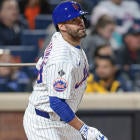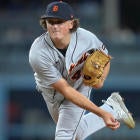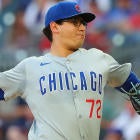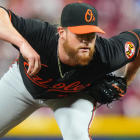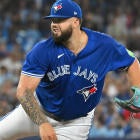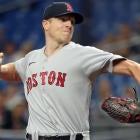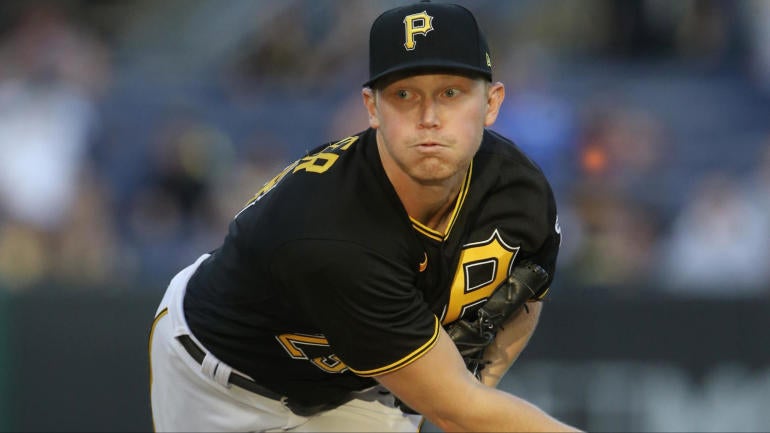
The biggest development of spring training isn't anything player-specific. MLB sent out a memo Friday announcing its intentions to crack down even harder on sticky substances.
The initial crackdown last June saw an immediate drop in spin rates across the league, but those rates had largely returned to normal by season's end. In response, MLB is now instructing umpires to examine pitchers' hands in addition to the areas where they typically hide foreign substances (hat, belt, etc.).
It's hard to say exactly what the impact will be. Spin rates were down across the board in the immediate aftermath of last year's crackdown, but some of the game's biggest bat-missers (Gerrit Cole, Trevor Bauer, Corbin Burnes) seemed to be affected the most. I suspect that if these new measures succeed in keeping sticky substances sidelined, there could be a flattening effect within the pitcher ranks, bringing the elites closer to the second tier. I was already inclined to go hitter/hitter in the first two rounds of drafts this season, but this development might steer me even more in that direction.
Of course, I also found this relevant nugget buried at the bottom of an article about a Giancarlo Stanton home run. From Bryan Hoch of MLB.com:
"Saturday marked the first day of "sticky stuff" enforcement this spring, with each pitcher checked as they came off the mound. [Manager Aaron] Boone said that pitchers are being provided with their choice of two tackier versions of rosin, which should help them get a better grip than last season."
So maybe the league is actually providing pitchers with what they need to spin the ball effectively, thus eliminating the temptation to cheat. I noticed that the average spin rate on Cole's fastball in his Grapefruit League debut Sunday was basically in line with last year's.
Here are some developments I can assess with greater confidence ...
1. The Tigers are serious about Spencer Torkelson, Riley Greene
GM Al Avila put it plainly right about the point when exhibition started, saying there would be no service time manipulation for the team's top two prospects, who each spent some time at Triple-A last year.
"I'm not arrogant enough to think that I can hold a guy back because we're going to make the playoffs anyway," he said. "You go full bore from Day 1 because those games at the beginning can mean everything at the end."
It would be easy to write it off as GM speak (service time manipulation is illegal, so why would he admit to it?) except that Avila left the Tigers with no suitable alternatives at either first base or center field. And with neither Torkelson nor Greene having done anything to hurt his chances this spring, the possibility of them making the team has become all the more palpable, with most Tigers beat writers outright projecting it. Both have become must-draft in standard 12-team leagues as a result. If anything, I haven't moved them up far enough in my rankings.
2. Julio Rodriguez has a realistic chance to make the team
The 21-year-old has given off best-prospect-in-baseball vibes from the time he was 17, so while he's played in only 46 games above A-ball (batting .362 in them, for what it's worth), it's not surprising that the Mariners would think he's ready for the big stage. And GM Jerry Dipoto basically said as much early this spring.
"I think, in a lot of ways, he is intent on wowing us, and he always has," Dipoto said. "He's a wonderful kid. He's well adjusted. He's incredibly talented. I think he's ready for the challenge on the big stage."
Between that and manager Scott Servais starting Rodriguez in center field almost every game, believing he's already the best option there defensively, it seems like the Mariners have gotten comfortable with the idea of having him around. The payoff for selecting him with a late-round pick now could be enormous.

Fantasy Baseball Draft Kit
Your ultimate baseball draft guide
Dominate your Fantasy Baseball draft with our free Draft Kit, which gives you must-have positional and Top 300 rankings in a printable format. Plus track your draft with our lineup builder and salary cap tracker.
Thanks for signing up!
Keep an eye on your inbox.
Sorry!
There was an error processing your subscription.
3. Cody Bellinger still looks broken
Bellinger has been a mechanical mess since his MVP-winning 2019 season. He showed up the next spring saying he had (inexplicably) overhauled his swing, which contributed to the first dip in production, and then after shoulder surgery the following offseason, his production slipped to the point of rendering him unusable last year. Surely, the offseason was enough to fix him, right? Well, so far he has struck out 14 times in 20 plate appearances.
Manager Dave Roberts thinks the 26-year-old is in his head too much and is also quick to point out that it's only spring training, but plate discipline tends to normalize quicker than other things. An inflated strikeout rate can be an early indication that a hitter has lost his way, as happened with Keston Hiura and Travis Shaw in previous springs. Strikeouts weren't even the most alarming aspect of Bellinger's struggles the past two years, so he may be sinking even deeper into the abyss.
4. McKenzie Gore appears to be fixed
Having been drafted third overall in 2017 and put together a 1.69 ERA, 0.83 WHIP and 12.0 K/9 two years later, Gore quickly emerged as the game's top pitching prospect, a title he held as recently as this time last year. But remember, there was no minor-league season in 2020, and behind the scenes, trouble was brewing. His complicated delivery, which is one of the keys to his success, had gotten out of sync, compromising both his stuff and command. He spent much of last season at extended spring training, working to rediscover it, and had to start over at Rookie ball when reintroduced to competition late in the year.
It wasn't clear then that he had rediscovered his form, which is why he completely dropped off several notable top-100 lists this offseason, but it's pretty clear now. He's been popping his fastball in at 98 mph this spring, and the results have been near flawless. He has allowed one hit through five shutout innings, striking out seven and, most notably, walking none. The Padres rotation may already be set without him, but when he does get the call, he may never look back.
5. Alejandro Kirk has an opening at DH
The Blue Jays have been less than forthright about their plans at DH, but we know they love Kirk's bat and, frankly, they should. As a rookie last year, the 23 year-old had a hard-hit rate like Freddie Freeman to go along with a strikeout rate like Yuli Gurriel. We also know that the Blue Jays are less enamored with Kirk's defense, which is why they won't just turn the catching job over to him.
Then they traded Randal Grichuk, Kirk's main obstacle to full-time DH duties, to the Rockies last week. Grichuk probably wouldn't have played much DH himself, but he would have bounced around the outfield, giving each of those three regulars semi-regular turns at DH. Maybe newcomer Raimel Tapia fills a similar role, but he isn't as good as Grichuk offensively or defensively. My hunch is that the trade frees up the DH spot enough for Kirk to play as much as the typical No. 1 catcher, if not even a little more.

Fantasy Baseball Today Newsletter
Your Cheat Code To Fantasy Baseball
You're destined to gain an edge over your friends with advice from the award-winning FBT crew.
Thanks for signing up!
Keep an eye on your inbox.
Sorry!
There was an error processing your subscription.
6. Keston Hiura's simplified swing is paying off
Considered by many to be the most polished hitter of the 2017 draft class, Hiura lived up to the hype and then some in his 2019 debut, slashing .303/.368/.570 in 84 games. But it's been all downhill since then, to the point that no one's even thinking about drafting him anymore. Maybe you should. He's regained some traction this spring with a simplified swing that has him impacting the ball like he did as a rookie, so far hitting as many home runs (three) as he has strikeouts.
"It helps me get down earlier and not think about when I want to get my timing started because pitchers are so quick to the plate now and they're varying their deliveries," Hiura said. "Getting rid of that toe tap definitely simplifies things a lot."
Basically, he used to have two timing mechanisms -- a leg kick and a toe tap --- and struggled to get them in sync. Now with only the leg kick, he's able to get the barrel to the ball again, his natural talents shining through. Is it enough to earn him at-bats at first base over Rowdy Tellez? We'll see.
7. Mitch Keller's velocity gains are legit
During the lull of the lockout, a video of Keller lighting up the radar gun at a North Carolina training facility (Tread Athletics) made the rounds on social media, but it was hard to know what to make of it. He averaged 94 mph on his fastball last year, but this video showed him sitting between 98 and 101. Was it a legitimate increase, and would it carry over to a game scenario?
We now know the answers are yes and yes. Justice delos Santos of MLB.com filled in the details. The work Keller put in with Tread Athletics was to lengthen his arm action, getting more out of his wrist and his legs, and sure enough, it has him hitting 98 consistently this spring. He'll have to throw strikes with it, which is something he's struggled to do in the past, but hitters now have to guard against the fastball unlike they have before, which should help his entire arsenal play up. This velocity bump may be what gets the former top prospect over the hump.
8. Carlos Rodon's velocity dip is behind him
Speaking of spring velocity readings, Rodon, now with the Giants, was back to hitting 98 mph in his first start last week. It's closer to what we saw from him during the first four months of last season than in the final month after his bout with shoulder inflammation, when he came back averaging 93. Was something more serious going on? Had he decided the velocity gains that fueled his breakout were more than his arm could sustain? Apparently not.
It's worth the reminder, then, that he ended last year with a 2.37 ERA, 0.96 WHIP and 12.6 K/9 -- numbers that compare to NL Cy Young winner Corbin Burnes and basically no one else. Plus, now Rodon is in a bigger park and with an organization with a reputation for maximizing veteran arms. In the span of 2 2/3 innings, his 2022 prospects went from concerning to promising. Sometimes, that's all it takes.
9. Jesus Luzardo is putting it all together
The 24-year-old left-hander went from Rookie of the Year contender in 2020 to trade fodder in the span of one year. Initial returns for the Marlins (6.44 ERA) weren't any better than he delivered for the Athletics (6.87), but the former has become something of a pitching factory in recent years.
Fittingly, Luzardo seems to have figured things out. He has yet to allow an earned run in seven innings, striking out seven and walking one, but even more impressive than the numbers are the changes to his arsenal. He averaged 97 mph in his latest outing Sunday, up 1.5 mph from last year, and he threw his best pitch, the curveball, 48 percent of the time. That's more than he's ever thrown it before, which is sometimes enough to fuel a breakout. With the improved velocity on top of it, it's easy to see front-line potential.
10. Jon Gray is indeed adding to his arsenal
It's true that Gray managed to navigate Coors Field like few pitchers before him, but given the caliber of prospect he was, it's inaccurate to say he lived up to his potential in his seven years with the Rockies. The hope when he left was that he'd be able to re-expand his arsenal after whittling it down to just two pitches, the only ones that played properly at Coors Field. Already, that hunch is coming to fruition. In his spring debut, Gray got all four of his strikeouts on a new slider that plays quite a bit differently from the one tailored to Colorado.
"It's moving a lot more," said Gray. "It's got a lot more horizontal action on it. It probably moves double the amount my old one does."
Movement is what the thin air of Coors Field worked to suppress, so it's understandable why such a slider might not have played there. And it's not all he's looking to add to his arsenal.
"I think the changeup is going to be a really good mix-in -- and [the] curveball too."
Here are a few more notable developments from around the league:
- Tony Gonsolin appears to have secured a spot in the Dodgers rotation despite the recent signing of Tyler Anderson. Gonsolin is the higher-upside pitcher, boasting a 2.85 ERA, 1.09 WHIP and 9.4 K/9 in his career.
- Logan Gilbert spent some time in the offseason working out with Jacob deGrom. He throws a firmer slider now that registers in the high 80s rather than low 80s like last year.
- Eduardo Rodriguez, who experimented with a slider in the postseason last year, thinks he "finally found one" and feels "really good with it." The 28-year-old left-hander, who has mostly succeeded by playing his fastball off his changeup, is off to a brilliant start this spring.
- Dominic Smith revealed that he was playing through a torn labrum in his shoulder last year, which might explain why he slumped to a .667 OPS after breaking through with a .993 OPS in 2020. The DH candidate is off to a nice start this spring.
- Meanwhile, Carlos Carrasco revealed he was playing with a bone fragment in his elbow that prevented him from fully extending his arm, which might explain why he had a 6.04 ERA. He's feeling much better now and has regained the movement on his secondaries. It would help if the Mets actually knew the health status of their players, huh?
- Sean Manaea's velocity has slipped back into the 88-90 mph range this spring. He averaged 92 last year, which helped fuel his breakout.
- Justin Verlander, now 39 and coming off Tommy John surgery, has looked just like we remember him through his first two starts, averaging right around 95 mph on his fastball.
- Former top prospect Jo Adell is looking primed for a breakout. He has three home runs and three stolen bases already.
- Prospect Cade Cavalli is making a surprisingly strong case to be part of the Nationals starting rotation, but it's still probably a long shot.
- Nolan Arenado, dissatisfied with hitting .255 in his first year outside of Coors Field, has changed the position of his hands to make himself quicker to the ball.
- Andrew McCutchen thinks he's figured out what went wrong against righties last year. "I spun off a lot of pitches last year, and I think a lot of that had to do with my knee," he said. "I couldn't drive the ball with authority to the right side of the field. I addressed all of those things this offseason to get myself back strong." The projected Brewers DH has already hit an opposite-field home run off a righty this spring.
- Casey Mize struck out six in three innings Thursday, showing the sort bat-missing potential that he lacked in his rookie season. He says he's changed the grip on his four-seamer.
- Yu Darvish has made some mechanical tweaks to prevent the hip pain that then brought about back and groin soreness in the second half last season, when his ERA ballooned. He has allowed just one run in seven innings this spring, striking out 10 and walking none.
- Yoan Moncada is aiming to steal 30 bases this year. He stole three last year.
- Trevor Rogers is working on a new slider grip. His fastball and changeup remain his go-to pitches.














